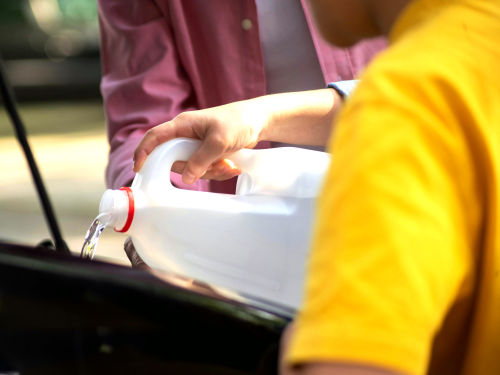115 THE FULL MONTY...
- Rob Lurted

- Jan 9
- 4 min read
Updated: Jan 17
After posting about the handy F.L.O.W.E.R. upkeep tips provided by The AA, I thought I’d check out what their full maintenance regime looked like. A yearly service covers a lot of this but there are still some things that the home mechanic/enthusiastic amateur can do to ensure the car is in tip-top condition and is safe for the road.
1. Keep Your Battery Healthy
Battery issues are the leading cause of vehicle breakdowns, especially when cars are used infrequently. Many vehicles come with a built-in battery monitor accessible through the manufacturer's app, or you can purchase a manual monitor to monitor your battery's condition.
A flat battery is most commonly caused by leaving the lights on after the engine is turned off. To avoid this, ensure all lights and electrical systems are switched off before exiting the car. Most vehicles provide a warning sound to alert you if the lights are left on.
Car batteries typically last between 3 to 5 years. If your battery is nearing the end of its lifespan, consider replacing it preemptively to avoid unexpected breakdowns.
2. Check And Change Your Oil Regularly
Regular oil changes are essential for improving your engine's performance and extending its lifespan. They also help you maximise fuel efficiency.
Engine oil includes additives like anti-wear agents, detergents, and dispersants that enhance its effectiveness. However, if the oil isn’t changed on time, these additives can degrade or lose effectiveness, leaving your engine less protected and potentially reducing performance.
3. Check Your Brakes
Your vehicle's braking system is highly complex and requires thorough inspections during annual MOT servicing.

The most common issues involve the brake pads, discs, and callipers. The best way to monitor your brakes is by assessing their performance while driving.
If you hear unusual noises, feel the car pulling to one side, or notice that it takes longer to slow down, have your brakes checked by a mechanic immediately.
Modern vehicles have dashboard warning lights to alert you to brake problems, so pay attention to these indicators.
4. Check Your Air Filters
Air filters prevent debris and dust from entering your vehicle’s engine, protecting it from damage and ensuring optimal performance. However, if the filter becomes clogged, it can reduce engine efficiency or cause damage.
Air filters are typically replaced during annual servicing, but you can easily replace them at home. Locate the air filter, usually housed in a plastic box connected to the engine via trunking. Unfasten any clips securing the box, remove the filter, and inspect it for dirt or debris. If the filter appears heavily clogged or dark in colour, it’s time to replace it with a new one.
5. Check Your Car's Fluids
Transmission fluid (for automatic cars), brake fluid, and engine coolant are key fluids to monitor when maintaining your vehicle. While dashboard warning lights will alert you if levels get low, checking them manually is also a good habit.
Brake Fluid
Inspect your brake fluid every few months. Locate the reservoir, typically a white container with dark fluid visible inside, and ensure the level is between the minimum and maximum markers. If it’s low, top it up with the appropriate brake fluid.
Washer Fluid
In winter, washer fluid is prone to freezing. Regularly check and refill it with a suitable winter-grade fluid to ensure your windscreen remains clear.
Coolant

Only check coolant when the engine is cool to avoid burns. Locate the expansion tank and verify that the coolant level is between the min and max marks. Low coolant can affect the car heater, causing cool air to blow from the vents even when the dial is set to 'hot'.
If you need to top up, use the correct type of antifreeze, as different types don’t mix well. Antifreeze prevents freezing in winter and protects against corrosion and scale buildup year-round.
6. Check Tyre Condition As Well As Pressure
While a flat tyre might be more evident after a quick visual check, other problems could require a closer look. The AA recommends checking your tyres - including the spare - every two weeks, as tyres naturally deflate over time. Watch for cuts and uneven wear, and ensure your tread is within legal limits.
Check the tyre pressure, too, so you don't put yourself at risk when you start driving again. The best time to do this is when the tyres are cold. The correct pressure should be in your vehicle handbook or printed on a label inside the door shuts or the fuel flap.
7. Cleaning Your Car
Keeping your car clean is an important part of maintaining its health. Spraying your car down and washing it with the right soap can help prevent corrosion and exterior damage. It’s also very important that your number plates are clean and legible.
8. Look For Signs Of Animal Visitors
Car engine bays can be appealing nesting spots for small rodents year-round. If your car has been idle for a while, inspect it for any signs of unwelcome visitors.
Check under the bonnet for evidence such as droppings, gnawed wires or pipework, damaged plastics, bedding materials, or stored food.

Common nesting areas include air filter boxes, spaces under fuse boxes and battery trays, and the area below the windscreen. However, any dry and concealed spot could be a potential target.
Remember to inspect the wheel arches and around the suspension for signs of activity.
If you discover any evidence of rodents, addressing the issue promptly is crucial, as they can cause significant damage, particularly to costly wiring looms.
9. Check Your Diesel Particulate Filter
If your diesel vehicle was manufactured after 2007, it likely features a Diesel Particulate Filter (DPF). The DPF traps soot particles generated during engine operation and stores them until a regeneration process (regen) is required to burn them off.
This regeneration typically occurs during a drive on a motorway or fast carriageway and lasts 10–15 miles. The process is usually seamless and unnoticed by the driver.
10. Give Electric Vehicles Just As Much Care
In plug-in vehicles, tyres, brakes, suspension, and general electrical systems are similar to those in petrol or diesel vehicles. The main distinction is the high-voltage system.
Many plug-in vehicles automatically maintain the 12-volt battery when connected to a charger. Check your vehicle handbook to see if this applies to your model. If your vehicle isn’t regularly plugged in, it’s a good idea to connect it periodically—at least once a month—to help maintain the systems.



Comments